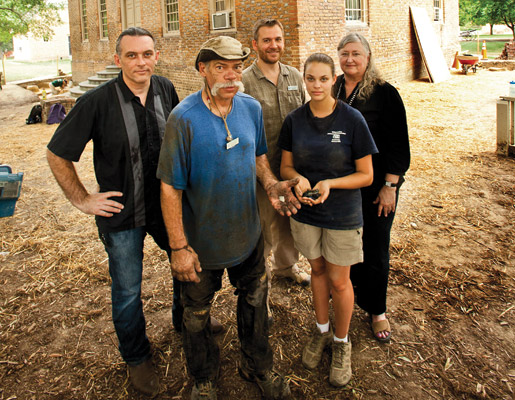Digging up our roots
Students join the hunt for historical relics at the Brafferton's base
A piece of stone and a scant double-handful of broken glass. It doesn’t look like much to the uninitiated, but the team of archaeologists working this summer at the base of the Brafferton knows that these artifacts are the richest kind of pay dirt. The stone is quartzite, flaked on two faces to make what might have been a scraping tool or a projectile point. The pieces of glass have been knapped—made into cutting or scraping implements by working their edges into sharp serrated cutting surfaces.
The quartzite and the knapped glass are the only artifacts found so far with unambiguous connections to students of William & Mary’s Indian School, which operated out of the Brafferton from 1723 to its closure during the Revolutionary War. Today, the Brafferton serves as William & Mary’s central administration building, housing the offices of the president and provost.
The Brafferton is scheduled to undergo a $4.5 million renovation, a project that prompted the archaeological examination of the site before construction work begins. The archaeology is partially funded by philanthropic support of the Brafferton renovation project, in particular a grant from the Lettie Pate Evans Foundation.
For much of the summer of 2011, William & Mary students in two field schools worked alongside graduate students in anthropology and professional archaeologists. The field schools were a collaborative effort between the College’s Department of Anthropology and the Colonial Williamsburg Foundation. Under the direction of Mark Kostro, a William & Mary Ph.D. student in anthropology and a staff archaeologist at Colonial Williamsburg, field school students excavated a two-meter wide trench around the building. When they weren’t digging, sifting or processing artifacts, the students attended classes to give context to their field work.
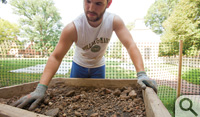 The Brafferton remains an important part of William & Mary’s Historic Campus and also occupies a singular place in the history and traditions of many American Indians. Danielle Moretti-Langholtz, director of the College’s American Indian Resource Center, gets regular calls from people who have connections to some of the 50 tribes linked to the Indian School who want to chase down a link to an ancestor who might have been an alumnus of the Indian School nearly three centuries ago.
The Brafferton remains an important part of William & Mary’s Historic Campus and also occupies a singular place in the history and traditions of many American Indians. Danielle Moretti-Langholtz, director of the College’s American Indian Resource Center, gets regular calls from people who have connections to some of the 50 tribes linked to the Indian School who want to chase down a link to an ancestor who might have been an alumnus of the Indian School nearly three centuries ago.
To reforge the Brafferton’s connection with the first Americans, Moretti-Langholtz and Ph.D. student Buck Woodard put together the Brafferton Legacy Group, a panel of William & Mary alumni with connections to the tribes linked with the Indian School. Members of the BLG are Paige Archer ’78 (Meherrin), Reginald Stewart ’86 (Chickahominy), Ashley Atkins ’09 (Pamunkey) and Annette Saunooke Clapsaddle ’05 (Eastern Band of Cherokee). The Legacy Group joined William & Mary President Taylor Reveley in a traditional tobacco-bundle ceremony in April.
The Legacy Group was set up as an advisory body to the anthropology department, and members remained active in the excavation throughout the field schools. Atkins is now a grad student in anthropology and participated in the dig. Archer visited the excavation several times, often bringing treats for the archaeologists. She served as an impromptu interpreter, too, talking about the excavation with the curious Williamsburg tourists peering over the brick wall along Jamestown Road.
At the brafferton’s base
The field schools excavated around the perimeter of the Brafferton, concentrating within the area to be affected by the pending renovation. The first findings were related to plantings around the foundation of the Brafferton since the Civil War. As the excavations progressed, an assortment of artifacts came to light, representing the 288 years of the Brafferton’s existence. Artifacts included fragments of 18th- and 19th-century pottery, glass and tobacco pipes, along with architectural debris such as nails and window glass. The students in the first session of the field school even found a human torso: a fragment of a porcelain doll that bore a “Germany” imprint.
One intriguing find was a stone finial bearing classical details. Edward Chappell, Roberts Director of Architectural and Archaeological Research at Colonial Williamsburg, said that the finial resembles 18th-century ornaments that were used on elaborate gateways. The artifact is probably a remnant of a pre-1776 fence that enclosed the Wren yard, he said.
Chappell speculated that the stone finial recovered from the Brafferton excavation is a relic of Revolutionary-era destruction in Williamsburg, a time of military occupation, during which the formal landscape of the College was disrupted and the President’s House accidentally burned.
The students also uncovered the underground elements of an early wrought-iron lightning conductor. Chappell noted that it appears similar to the devices that were installed at Bruton Parish Church, the 1770 Courthouse and the Public Hospital in Williamsburg.
The archaeologists uncovered a set of post holes, extending eastward from the northeast corner of the Brafferton. Kostro points out that the holes correspond with a fence shown on the 1782 “Frenchman’s Map,” a sketch of Williamsburg that’s part of the holdings of Swem Library’s Special Collections Research Center. Many of the most important artifacts, including the finial and the quartzite piece, were found in postholes, he added.
Other artifacts render associations that are less Euro-centric. Early in the first field school, archaeologists uncovered two glass beads and an item known as a “jingling cone” or “tinkling cone.”
“They’re related to adornment,” Kostro said, “They’re known from both African American as well as Native American contexts.” The two blue glass beads are around three millimeters in diameter—Kostro says they’re likely Venetian or Dutch in origin. The cone is a thumbnail-sized, thin, triangular piece of trade copper folded to form a cone-shaped object—not a common archaeological find in Virginia, he added.
The beads and copper cone could have been associated with students of the Indian School, Kostro said, but the quartzite tool and knapped glass certainly were.
“I’ve seen many of these. I would say it’s Native American,” Jeff Brown said, turning the quartzite tool in his hands. Brown, a member of the Pamunkey tribe, is a veteran of the 2003-10 excavations at Werowocomoco, the capital of Chief Powhatan. He was a mentor to the students throughout both field schools and part of the crew that continued the excavations after the field schools ended in August.
The knapped glass pieces are evidence of how Native Americans adapted to the availability of new types of material introduced by European colonists, Kostro says. Pieces of broken bottles are among the most common Colonial-era artifacts found, he added, and the shards were a readily available raw material for toolmaking.
“They’re pieces of glass that’s been fashioned into some kind of tool—a cutting tool, a projectile point or a scraper,” he explained. “They used the same manufacturing process that Native Americans used for making stone tools for millennia. All they’re doing is changing materials.”
Kostro added that the glass might have been preferable to the area’s native stone traditionally used for making tools. “Quartzite is really a very difficult material to make stone tools out of,” he said. “It doesn’t have a very predictable fracture pattern. Glass, by comparison, is much easier.”
Learning how to dig
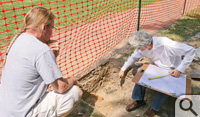 The Brafferton field schools centered around two concepts: archaeological technique and historical relevance. In the field, students learned using a shovel meant more than randomly pushing it into the ground. “It’s not just mindless digging,” remarked Morgan Dyson ’13.
The Brafferton field schools centered around two concepts: archaeological technique and historical relevance. In the field, students learned using a shovel meant more than randomly pushing it into the ground. “It’s not just mindless digging,” remarked Morgan Dyson ’13.
Students in the first session of the field school, held from May 31 to July 1, went into the field with different expectations. Some, like Danny Mosier ’12, knew the basics beforehand but otherwise were surprised by the requirements of the field school.
“I was introduced to some basic concepts in my anthropology classes, but nothing actually like field work,” he said.
Evan Rutherford ’13 shared a similar experience. Like Mosier, he took Intro to Archaeology. Still, he feared the field school would prove full of tedious work. However, the class excited him enough to make him return for the second session.
“Since I learned so much this semester, why not come back and see what else I can learn in the second half?” he said.
Working around the base of the Brafferton with graduate students and professional archaeologists, students learned the techniques for excavating features around the building. For example, when digging around the foundation, students used a trowel. Rather than simply plunging the tool into the ground, students had to learn the correct techniques to minimize damage to fragile artifacts. Correct trowelling, they learned, is done holding the tool with the point slightly elevated, keeping the bottom edge at an angle of 35 degrees from the ground.
Another technique students learned was triangulation. The purpose of triangulation in the field school was to set up mapping grids, to keep track of where artifacts and features were discovered. Joshua Anish ’13 was excited when he learned how to do it around the Brafferton.
“You take two points, then you take two measuring tapes, and you bring them together at a certain point,” he explained. “That was amazing. I wouldn’t have thought about it.”
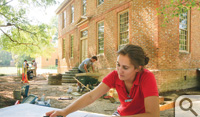 More than digging and sifting
More than digging and sifting
There is more to a field school than digging and sifting. Once a week, the students attended lectures on artifact identification, archaeological conservation, environmental archaeology and zooarchaeology at Colonial Williamsburg’s archaeology lab. In one lecture, Buck Woodard, a Ph.D. student at the College and director of the American Indian Initiative at Colonial Williamsburg, gave an overview of the history of Native Americans in the Tidewater region. Woodard said that local Indian communities were recruited to help the British during the French and Indian War. One native soldier, educated at the Brafferton, was Capt. Tom Step, who, under the command of George Washington, rallied natives to the British cause.
Woodard also discussed the history of the Indian School and the Brafferton. He told the students that the school predates the Brafferton, having been started around 1700. Woodard said the first students were Virginia Siouan captives—perhaps Saponi or Catawba—from what was then the Virginia frontier. In 1713-14, treaties with the Virginia colony encouraged Native American leaders to send their sons to the school, he said.
By the end of the school in the 18th century, Native American boys were being educated in Christianity and the basics of reading and writing. The enrollment numbers have been lost over time. As historical records are scarce, archaeology has emerged as the best connection to the life of Native Americans in the early days of Virginia.
“It’s striking how little historical archaeology has been conducted on American Indian sites in Virginia,” said Martin Gallivan, an anthropology professor at the College. “The Brafferton project is a prime example of several recent William & Mary projects shedding light on the post-1607 native experience in the Chesapeake.”
Involvement of William & Mary students in the Brafferton archaeology, through the field schools, was a conscious decision, says Kathleen Bragdon, chair of the anthropology department. “This is the second-oldest building at the second-oldest university in America,” she said. “It’s important that our undergraduates have a part in this project at a place that is so important to three cultures in America.”
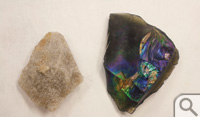 The third culture Bragdon referred to is African American. Eighteenth-century Williamsburg was virtually built by African Americans, Kostro explained.
The third culture Bragdon referred to is African American. Eighteenth-century Williamsburg was virtually built by African Americans, Kostro explained.
“Almost every building that was built was done so by enslaved Africans,” he said. “They made up 50 percent of Williamsburg’s 18th-century population, and certainly as laborers, they made up the lion’s share of the workforce.”
Examination of the artifacts removed from around the Brafferton’s base will be of interest to faculty participating in William & Mary’s Lemon Project, an ongoing initiative that examines the role of slavery in the College’s early years.
“We are interested in knowing more about how enslaved people lived and worked here, and any archaeological evidence of their material culture,” said Robert Vinson, Lemon Project co-chair. “We are also looking for clues about where enslaved people might have been buried. We still do not know the location of the cemetery for enslaved people, if indeed there was one.”
Many of the anthropologists, and members of the Brafferton Legacy Group, hope the project will provide an opportunity for the College to re-engage with Native American communities that have William & Mary roots that predate even Thomas Jefferson’s.
“Our hope is to reach out to the many, many other communities that had members who went to the Brafferton,” Ashley Atkins said.
Faculty, students and members of the Brafferton Legacy group first came together at the April prayer ceremony. The event allowed native people an opportunity to reconnect with the Brafferton and sing honor songs in remembrance of William & Mary’s Indian students. The focal point of the ceremony, the tobacco bundle, will be respectfully interred at the Brafferton at the conclusion of the excavations. ![]()














